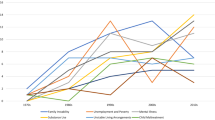Abstract
Study Purpose
Injury remains the leading cause of death in children aged 1 to 4 years. Past studies of determinants of injuries among young children have most often focused on the microlevel, examining characteristics of the child, parent, family, and home environments. We sought to determine whether and how selected neighborhood economic and physical characteristics within these low-income communities are related to differences in risk of events with injury-producing potential among infants and young children.
Methods
Our study used both individual-level data and information on the characteristics of the neighborhood of residence to describe the prevalence of events with injury-producing potential among infants and young children in three low-income communities in Baltimore City, Maryland. Our sample was 288 respondents who participated in a random household survey. Information on respondent (age, employment, and length of residence in the neighborhood) and neighborhood characteristics (average per capita income, rate of housing violations, and crime rate) were available. Methods of multilevel Poisson regression analysis were employed to identify which of these characteristics were associated with increased risk of experiencing an event with injury-producing potential in the month prior to the interview.
Results
Although all three communities were considered low income, considerable variation in neighborhood characteristics and 1-month prevalence rates of events with injury-producing potential were observed. Younger age of respondent and higher rates of housing violations were associated significantly with increased risk of a child under 5 years old in the household experiencing an event with injury-producing potential.
Conclusions
Information on community characteristics was important to understanding the risks for injuries and could be used to develop community-based prevention interventions.
Similar content being viewed by others
References
Institute of Medicine.Reducing the Burden of Injuries. Washington, DC: National Academy Press; 1999.
Wilson M, Baker SP, Teret SP, Shock S, Garbarino J.Saving Children: a Guide to Injury Prevention. New York: Oxford University Press; 1991.
Fingerhut L, Warner M.Injury Chartbook, Health United States, 1996–97. Hyattsville, MD: National Center for Health Statistics; 1997.
Peterson L, Bartelstone J, Kern T, Gillies R. Parents' socialization of children's injury prevention: description and some initial parameters.Child Dev. 1995;66(1):224–235.
Garling A, Garling T. Mothers' anticipation and prevention of unintentional injury to young children in the home.J Pediatr Psychol. 1995;20(1):23–36.
Gielen AC, Wilson ME, Faden RR, Wissow L, Harvilchuck J. In-home injury prevention practices for infants and toddlers: the role of parental beliefs, barriers, and housing quality.Health Educ Q. 1995 February;22(1):85–95.
Brooks-Gunn J, Duncan G, Aber J, editors,Neighborhood Poverty: Context and Consequences for Children. New York: Russell Sage Foundation; 1997.
O'Campo P, Gielen AC, Faden RR, Xue X, Kass N, Wang M. Violence by male partners against women during the childbearing year: a contextual analysis.Am J Public Health. 1995;85:1092–1097.
O'Campo P, Xue X, Wang MC, Caughy M. Neighborhood risk factors for low birthweight in Baltimore: a multi-level analysis.Am J Public Health. 1997 July;87(7):1113–1118.
McLeroy KR, Bibeau D, Steckler A, Glanz K. An ecological perspective on health promotion programs.Health Educ Q. 1988 Winter;15(4):351–377.
Wehr E, Jameson EJ. Beyond benefits: the importance of a pediatric standard in private insurance contracts to ensuring health care access for children.Future Child. 1994;4(3): 115–133.
Durken MS, Davidson LL, Kuhn L, O'Connor P, Barlow B. Low-income neighborhoods and the risk of severe pediatric injury: a small-area analysis in northern Manhattan.Am J Public Health. 1994;84(4):587–592.
Alwash R, McCarthy M. Injury controls in childhood.Dev Behav: Older Children and Adolescents. 1992;39:471–485.
Braddock M, Lapidus G, Gregorio D, Kapp M, Banco L. Population, income and ecological correlates of pedestrian injury.Pediatrics. 1991;88:1242–1247.
National Committee for Injury Prevention and Control. Injury prevention: meeting the challenge.Am J Prev Med. 1989;5(3 suppl):1–303.
Reading R, Langford IH, Haynes R, Lovett A. Accidents to preschool children: comparing family and neighborhood risk factors.Soc Sci Med. 1999 February;48(3):321–330.
Goldstein H.Multi-level Models Project. London: Institute of Education, University of London; 1995.
Roberts I, Norton R, Taua B. Child pedestrian injury rates: the importance of “exposure to risk” relating to socioeconomic and ethnic differences, in Auckland, New Zealand.J Epidemiol Community Health. 1996;50:162–165.
Stone D. Research on injury prevention: time for an international agenda?J Epidemiol Community Health. 1996;50:127–130.
Baker SP, O'Neill B, Ginsburg M, Li G.The Injury Fact Book. 2nd ed. New York: Oxford University Press; 1992.
Connell J, Aber J, Walker G. How do urban communities affect youth? Using social science research to inform the design and evaluation of comprehensive community initiatives. In: Connell J, Kubisch A, Schorr L, and Weiss C, eds.New Approaches to Evaluating Community Initiatives. Washington, DC: Aspen Institute; 1995.
Jones K, Duncan C. Individuals and their ecologies: analyzing the geography of chronic illness within a multilevel modeling framework.Health Place. 1995;1(1):27–40.
DiPrete TA, Forristal J. Multilevel models: methods and substance.Annu Rev Sociol. 1994;20:331–357.
Author information
Authors and Affiliations
Additional information
Dr. O'Campo is from the Departments of Maternal and Child Health and Epidemiology and Dr. Gielen is from the Department of Health Policy and Management, School of Hygiene and Public Health, Johns Hopkins University
Dr. Wilson is from the Department of Pediatrics, School of Medicine, Johns Hopkins University.
Rights and permissions
About this article
Cite this article
O'Campo, P., Rao, R.P., Gielen, A.C. et al. Injury-producing events among children in low-income communities: The role of community characteristics. J Urban Health 77, 34–49 (2000). https://doi.org/10.1007/BF02350961
Issue Date:
DOI: https://doi.org/10.1007/BF02350961




